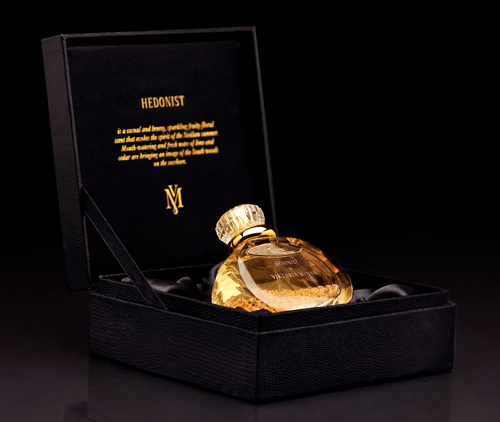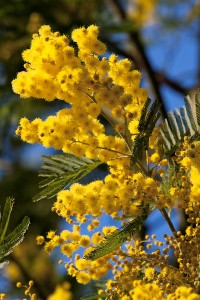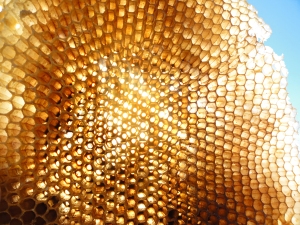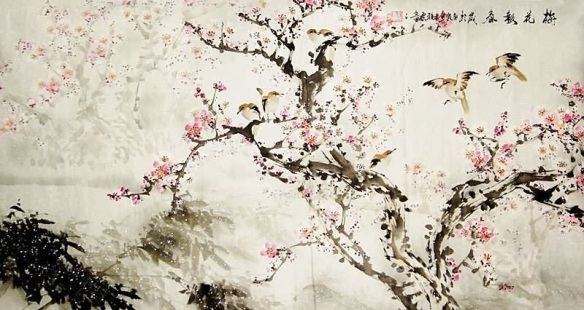
Source: UniqueLiving.com
A stroll in Provence at the end of Spring. The scent of peaches and orange blossoms in the air. Fresh citruses and sparkling champagne. Heavily-laden mimosa trees adding colours of yellow, white and green. Bees buzzing everywhere, zipping from the fragrant flowers to honeycombs dripping with thick sweetness.

Viktoria Minya. Source: Viktoria Minya.
Those are the images evoked by Hedonist, a new perfume and the first in a line from the independent Paris house of Parfums Viktoria Minya. Ms. Minya spent many years studying the art of fragrance production in Grasse — the center for French (if not world) perfumery that is located in Provence — and then in working for various fragrance creation companies. Ms. Minya recently explained her philosophy and the goal behind Hedonist in an interview she gave to Fragrantica:
Impregnated of Grasse’s spirit, in the cradle of perfumery, I thought a perfume should be a celebration, it should be crowning your day, and it should be a moment of pure joy. I created Hedonist according to these values in my mind. I wanted it really to be a piece of beauty[.]
The spirit of Grasse is very strong in Hedonist and is probably why images of Provence are so vivid in my mind, recalling part of my childhood summers in the area. And the perfume is, indeed, beautiful, though I have to admit that hedonistic excess is not really the feel of it for me. Instead, it makes me feel extremely serene, soothed by the sweetness of honey and fruited flowers.

Hedonist in its handmade wooden box that is “fashioned to capture the sleek look and feel of snakeskin leather.” Source: Viktoria Minya website.
Nonetheless, Hedonist is described as follows:
A powerful and provocative perfume for a woman who dares to be true to her desires. Lush notes of jasmine and orange blossom absolute flirt with the dark intensity of rum and the world’s finest woods for a scent that is as captivating as it is unforgettable.

Source: Viktoria Minya.
Hedonist is presented within a beautifully crafted bottle filled with hundreds of genuine bohemian crystals that sparkle brilliantly in the divine golden liquid and the bottle itself is enclosed within a handmade wooden box fashioned to capture the sleek look and feel of snakeskin leather.
The notes in the perfume, as compiled from both Fragrantica and an interview there with Viktoria Minya, are:
Top notes: Rum CO2, bergamot, peach;
Heart notes: Indian jasmine absolute, Tunisian orange flower absolute, osmanthus absolute, tobacco;
Base notes: Haitian vetyver, Virginia cedar oil, Indonesian Patchouli, and vanilla.
Fragrantica classifies Hedonist as a “woody chypre.” Frankly, that leaves me utterly baffled. The perfume is hardly a chypre and has no oakmoss. On my skin, it’s not particularly woody, either! Instead, it’s a lovely, very sweet fruit-floral with a very cozy feel, thanks to its honey and vanilla heart.

Bees on a honeycomb. Source: McDanielHoneyFarm.com
From the very first whiff, Hedonist is pure honey. A tidal wave of honey that is rich and warm with an element of almost bourbon-like richness beneath the tone. Yet, surprisingly, it’s not very thick, boozy or heavy; it doesn’t feel like the sort of boozy heaviness of Guerlain‘s Spiriteuse Double Vanille with its genuinely rum (and rum raisin) accord. Here, instead, it feels more like very dark honeycombs, infused with florals.

Source: RebootwithJoe.com
Seconds after that opening burst, there is lush peach, heady jasmine, citrus notes and some orange blossom. The jasmine is beautifully intertwined with the peach which is so ripe and sweet, it feels as though its juices are dribbling down your chin. The fruity note is also quietly underscored by the honeyed apricot aspect of osmanthus. There are no significant orange accords, however, and the orange blossom is very muted at this time.
In comparison, the citrus notes are much more prominent in the opening minutes. They are fresh and sparkling, seeming at times like bergamot, while, at other times, adding a very subtle, quiet nuance of lemony freshness. They are joined by just a hint of green vetiver, but it is bright and a bit more like lemon grass than the usual earthy, dark, rooty note. With the citrus notes, it creates the image of the green leaves surrounding a peach.
The interesting part of Hedonist’s opening is the distinctly soapy undertone to the perfume. While I suspect it stems from the orange blossoms, what’s unusual about it is that it really feels like soapy woods! White woods, soft and light, but soapy nonetheless. The conjunction of that soapy note with Hedonist’s fizzy brightness calls to mind aldehydes, but also champagne. In this case, both the drink and YSL‘s Champagne/Yvresse perfume which I adore and which is one of my long-standing “happy” perfumes. It is a beautiful, fruity-floral fragrance with peaches, nectarines, apricots, vetiver, and fizzy aldehydes.

Source: Philolog at Traumwerk.Stanford.edu
That same sparkling feel exists here with Hedonist, and its bubbly pop leads me to think that either aldehydes or hedione are part of the perfume. For one thing, hedione has long been a key part of 20th century perfumery, especially for French perfumes. While it is often used in place of jasmine absolute, hedione is also sometimes used for its own characteristics in order to create a bright, green, lemon-nuanced fizzy note. Here, the jasmine note is not indolic, over-ripe, sour or plastic-y but, rather, very airy and almost green — the way it would be if hedione were used.
As for the aldehydes, they too are often added to create that shimmery brightness which is evident here. For the record, Ms. Minya says there are no aldehydes in the scent, but it sometimes feels like it. Not merely because of the occasionally soapy aspect to the perfume (though that vanishes after an hour), but also because of the sparkle and airiness. For all that Hedonist feels like a very heady perfume, it’s actually not opaque or thick at all. After that initial heaviness from the honey note (the Rum CO2) in the opening minutes, the perfume is actually quite light in feel. It’s definitely not oppressively weighted down or indolically narcotic.
 I wouldn’t be surprised if there are other notes in the perfume that are not included on the list. For some reason, it almost feels as though there is a subtle mimosa note to all the cheerful, happy, sweet yellowness of the scent. I think it’s because I keep seeing yellow before my eyes when I smell the perfume. (And, also, because mimosas were also a big part of my childhood in the South of France.) At the same time, Hedonist also seems to have a light musk note underlying everything. That accord becomes more evident as time passes and the perfume develops more into its core base: honey, peach and beeswax over a light foundation of musk with vanilla.
I wouldn’t be surprised if there are other notes in the perfume that are not included on the list. For some reason, it almost feels as though there is a subtle mimosa note to all the cheerful, happy, sweet yellowness of the scent. I think it’s because I keep seeing yellow before my eyes when I smell the perfume. (And, also, because mimosas were also a big part of my childhood in the South of France.) At the same time, Hedonist also seems to have a light musk note underlying everything. That accord becomes more evident as time passes and the perfume develops more into its core base: honey, peach and beeswax over a light foundation of musk with vanilla.
After an hour, the notes change a little in nuance, but the perfume’s fundamental characteristic remains the same. The citrus notes have faded away completely to be replaced by more woody ones, along with the advent of orange blossom. The latter is subtle and well-blended into the jasmine. As time progresses, however, it becomes even less evident on my skin, though it occasionally pops up, here and there, in different degrees of strength. On my skin, Hedonist is not really an orange blossom scent, but a peach and honey one. As the other notes start to drop away, the honey becomes even more evident, strengthened by beeswax and the image of rich honeycombs. There is also the start of the vanilla undertone; it’s very soft and gauzy but, simultaneously, rich and creamy. When combined with the honey, beeswax and ripe, juicy peaches, the overall impression is of great sweetness.
The woodsy notes are very muted on my skin. There is a quiet element of cedar wood in the background, but it is just the barest shimmer. As for tobacco leaves, the first of my two tests of Hedonist showed the subtle hint of sweetened, dry tobacco leaves in the opening ten minutes of the scent, but it disappeared soon thereafter, never to reappear in any significant way. During my second test, however, both the tobacco leaves and the cedar wood were much more evident. They appeared at the end of the second hour, and I suspect it’s because I applied a far greater quantity of Hedonist than I did during my first test.
Another reason for the (small) difference might be because Hedoniste is a beautifully blended scent. Everything melds together in one very harmonious balance, making a few of the individual notes hard to detect in any significant way (with the exception of the honey). The background notes add to the richness of the scent in an indirect, subtle way, but they never visible morph the perfume into one thing or another. Instead, the core essence remains the same.
And that essence is a very classique scent. Hedonist has a very old-French aspect to it, though it’s not weighted down by some of the more traditional elements in French perfumery like oakmoss, powder, civet or patchouli. (Ms. Minya said in her interview with Fragrantica that patchouli was one of the notes in the perfume; I can’t smell it.) I think the airiness makes Hedoniste a very modern sort of classique fruity-floral. It is not trying to be revolutionary, unsettling or edgy; it simply wants to be beautiful and elegant.

Close-up of a honeycomb.
Source: Robert.Maro.net
Hedonist succeeds in that goal. Personally, however, I found it a much more soothing, serene, cozy scent than something sensuously hedonistic or sexy. It actually reminded me at times of Couvent de Minimes’ Honey and Shea body wash that I always turn to for its soothing, comforting qualities. Whatever Hedonist’s other elements or nuances, on my skin, it was first and foremost an uncomplicated, fruited honey, honeycomb and beeswax scent — and I loved it for that. And the perfume’s final drydown of honey, beeswax, vanilla and light musk was so pretty and cozy, I felt like curling up like a cat.
Hedonist is a strong perfume (though stronger if you apply more than the equivalent of 2 small sprays), but, as noted earlier, the feel is surprisingly light as a whole. The sillage starts as strong but, after the opening hour, became a touch above moderate in its projection on my skin. However, I was dabbing it on, so I suspect the perfume would be stronger if you applied Hedonist via an aerosolized spray bottle. Nonetheless, the first time I tested it, I was surprised by how quickly the fragrance became soft — which I think will be a definite bonus for those who prefer a less powerful scent. The perfume became very close to the skin only around the third hour, detectable only by bringing my nose to my arm. It hovered there as a soft, sweet veil for a number of hours. In terms of longevity, Hedonist lasted just about 9 hours on my perfume-consuming skin when I applied a lot, and approximately 7.5 when I applied less.
Hedonist’s richness is underscored by its utterly spectacular, luxurious presentation. Though I haven’t seen it in person, the photographs show a bottle that is filled with 500, genuine, Bohemian crystals which create a glittering, sparkling, jeweled effect that I find to be really stunning. I also think it happens to mimic the perfume’s very fizzy, champagne-like feel.

Source: Viktoria Minya.
All in all, Hedonist is an extremely sweet, very feminine scent and would be perfect for those who love sweet fruity-florals. Even those who normally shy away from florals and prefer gourmand scents may be drawn to it, thanks to all that lovely honey and the quiet vanilla in the background. It is far too feminine, in my opinion, for the majority of men to pull of it off, but men apparently love it on their girlfriends or wives. In her interview with Fragrantica, Ms. Minya said women who tested Hedonist “all liked the perfume, but their boyfriends/husbands were actually going crazy for it and begging their wife/girlfriends to wear it.”
I wear perfume for myself, not for others or their reaction to it, and I would definitely wear Hedonist. It’s one of those easy, uncomplicated scents that makes me feel very cheerful, cozy and warm. It’s a very happy scent that seems to have bottled the bright sunshine of Provence. Sparkle, cheerfulness and sweetness — all with beautiful crystals. I’m a fan.
DISCLOSURE: Sample provided courtesy of Viktoria Minya. However, that did not impact this review. As always, I make it very clear at the outset that samples are no guarantee of a positive review and that my first obligation is honesty to my readers.
DETAILS:
Cost & Availability: Hedonist is an Eau de parfum that is available directly from Viktoria Minya where it costs €130 (or, approximately, $168 at the current exchange rate) for a 45 ml/1.5 fl oz. bottle filled with 500 Bohemian crystals. Viktoria Minya Parfums offers a flat-rate shipping fee of €9 (or approximately $11.50). There are no geographic restrictions and she will ship everywhere. Samples are also available for €5 (or, approximately, $6.50) for a 1.8 ml vial with free shipping. Samples are now available from US stores, but you still get a better deal (given the 1.8 ml size) if order from the company with the free shipping. In the U.S.: Hedonist is now available at Luckyscent which sells the bottle for $195 with 0.8 oz samples for $5. Surrender to Chance also sells samples starting at $6.49 for a 1/2 ml vial.
Flower of Immortality was composed as the memory of the utopian paradise, where the fragrance of peach blossoms brings a promise of hospitality and immortality. The smooth and juicy scent of White Peach, interweaved by the sweet and powdery notes of Carrot and Iris. A dazzling breeze of Blackcurrant Bud absolute refreshes while the exquisite Rose Crystal is softened by the Tonka Bean and the scent of Vanilla beans drying in the sun.
 The perfume was created by Calice Becker and the full list of its notes, as compiled from both Fragrantica and LuckyScent, is as follows:
The perfume was created by Calice Becker and the full list of its notes, as compiled from both Fragrantica and LuckyScent, is as follows:
























